David Meerman Scott's Blog, page 86
April 10, 2012
Will Facebook destroy Instagram?
 I've talked before about why I love Instagram.
I've talked before about why I love Instagram.
Instagram is a photo sharing application that makes it easy and fun to manipulate a photo with various filters and turn it into instant art. Then with a few clicks, you can share your photo with a caption via Twitter, Facebook, and other social networks.
For example, a few days ago in Krakow, Poland I shot a mundane photo of some telephone booths with my iPhone and used Instagram to turn it into instant art.
Yesterday, Facebook announced a USD $1 billion acquisition of Instagram.
You can read the Facebook statement here.
I hope Facebook will not destroy Instagram
But I'm worried they will.
It seems to me that the big social players – Google, Facebook, and Twitter – are building walled gardens around their users in the exact same way that portals like Lycos, Excite, AOL, and Yahoo did a decade ago.
They hoard users and don't like to have hooks into each others' services.
Yes, I do understand that companies need to make money. I get that. Instagram's founders, employees, and investors deserve a payday.
How are Lycos, Excite, AOL, and Yahoo faring today??!!
Building walled gardens of Portal 2.0 is bad for users and ultimately leads to failure.
Here's more on this idea: Portal 2.0 take social backwards to the 1990s.
While the Zuck's statement says things won't change, I'm pessimistic.
I can imagine a day in the near future when you can no longer post Instagram directly to Twitter.
I'm also seeing a future where we are forced into the Facebook mobile app to use Instagram.
Or perhaps, just like Google not playing nice with Twitter, you won't be able to access Instagram from other social sites.
Read the Zuck's statement. Has he earned your trust? Do you believe him? Or if you are an Instagram fanboy like me are you worried too?
My friend Ann Handley introduced me to Instagram. So went over to Ann's Twitter to see her take. "I love what she said: For many fans of Instagram, the news that Facebook is acquiring the photo-sharing mobile platform is a little like hearing that your best friend is engaged to that jerk. She might be thrilled. But you can't help but feel a sense of doom about the whole arrangement." Here is Ann's thoughtful post.
What do you think? Are you worried like me and Ann? Or are we missing something?
Photo: Shot by David Meerman Scott near Krakow, Poland on an iPhone 4S and tweaked with Instagram. CC
April 9, 2012
Do not vague up your content
Over the years, I've read countless corporate blogs, seen a bunch of videos, and watched tons of Twitter feeds that look as if the PR pros or Marketing geniuses have gotten their grubby little hands into the mix.
The language is clean but generic. The passion is non-existent. And corporate messages are inserted at every opportunity.
When you create content to educate and inform, authenticity is a must. You must create information that comes from the passion of caring deeply about a subject.
Don't let your marketing communications or public relations staff vague up your stuff. Don't let the agencies MarCom it to death.
As soon as content has been through the Marketing Communications wringer and the PR gauntlet, it ceases to be authentic and people don't pay attention.
Resist the urge to message.
Allow people to let it all hang out, quirks and all. Your readers will thank you for it. And your business will prosper.
April 4, 2012
How to do something audacious
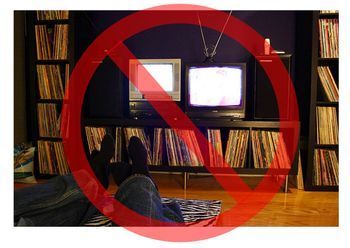 According to Nielsen, the average American spends 158 hours each month watching television(!!).
According to Nielsen, the average American spends 158 hours each month watching television(!!).
That's 1,896 hours - 79 full days - per year in front of the boob tube.
In a typical working lifetime from age 20 to age 65, based on these stats, the average American spends more than nine full years staring at the box.
You know where I'm going with this...
Cut out television and you can do anything
People frequently ask me how I find the time to have written 8 books in a decade.
It's easy!
I don't watch television at all (except in the morning when I am on my elliptical trainer).
Do something audacious!
Write a book, start a company, run a marathon, establish a nonprofit, build a house, play the piano. You can do these or anything else you care to do!
If you believe Malcolm Gladwell's idea in Outliers - that you need 10,000 hours of practice to become world class at a task - consider how damned easy it is to find the time! Just cut out television for 5.3 years.
Stop sitting there.
photo credit (without the "no" symbol): Kathleen Farley via photopin cc
April 2, 2012
B2B sales leads are too important for salespeople
Every salesperson loves leads.
And in most B2B companies marketing people spend lots of effort providing them.
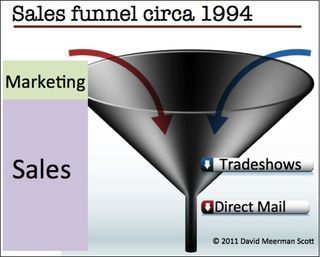 But too often, especially in B2B sales, there's an artificial demarcation between the role of sales and that of marketing.
But too often, especially in B2B sales, there's an artificial demarcation between the role of sales and that of marketing.
Consider the tradeshow: many companies spend thousands of marketing dollars to exhibit at important industry events. But after the show concludes, marketing simply ties a pretty ribbon around the business cards they received from prospects and tosses the leads over their shoulder to the sales manager.
B2B sales and marketing circa 2012
How can you deliver valuable information to people who express interest in your organization? How can you do it without annoying them?
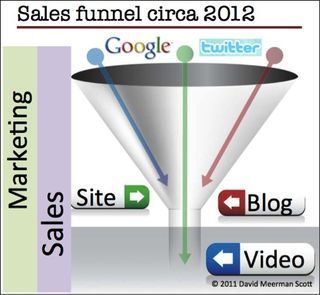 How about warming up potential customers by giving them gifts of valuable content well before the salesperson bugs them by triying to sell something?
How about warming up potential customers by giving them gifts of valuable content well before the salesperson bugs them by triying to sell something?
March 28, 2012
Harry Potter ebooks and generating attention for your business

Last June, Harry Potter author J.K. Rowling launched Pottermore, a fan site that was initially launched as a private beta. I wrote about it here Pottermore, Apple and "the secret will soon be revealed" form of real-time marketing. I managed to get a beta login, so I'm a registered user on the Pottermore site.
Last night got an email saying that the new Pottermore ebook store is open and that the Harry Potter books are (finally) available in electronic format.
This is significant because it is the first time that Harry Potter books are available as ebooks and the only place to buy them is on the author's own site. (If you go to Amazon to buy a Kindle version of a Harry Potter book, you're re-directed to Pottermore).
Attention
The book business is changing. So is the music business. And these changes have ramifications in your business too: How you generating attention?
Now authors can easily get a book out without going to a publisher and without using paper. And they can control their distribution.
Or they can choose to lose control and make their work completely free with no registration required.
That's not to say that traditional publishing is going away. I actually think print books and the big publishers have a future in the new ecosystem.
You no longer need to convince an editor in New York or an A&R guy in LA that your work is worthy.
Now you can create your own audience, build your fan base, publish your art, and control its distribution. Or you can make your work completely free so you can spread it far and wide like Summer Land did.
Seth Godin has been talking about these themes on his blog and on his Domino Project site.
Check out this Domino Project post from Seth on what happens when you flip scarcity with abundance (hint: everything changes).
March 27, 2012
The right measurements are required to achieve tough goals
In the past year and a half I have lost 40 pounds.
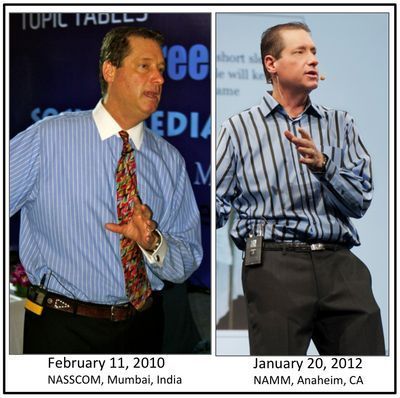 But losing 40 pounds actually took two decades because that's how long I was paying attention to the wrong measurement and failing.
But losing 40 pounds actually took two decades because that's how long I was paying attention to the wrong measurement and failing.
When I measured just on my weight, I couldn't lose weight. No matter what I did I stayed basically the same.
However, when I measured different things such as bodyfat percentage, metabolic age, calories burned, and the foods I eat, I changed my behaviors leading directly to weight loss.
I see the same idea at work with organizations and how they measure success. I'll share those ideas in a moment, but first I want to talk about my health.
Bodyfat, burning calories, eating right, and metabolic age.
My exercise.
I use an elliptical trainer every morning. I used to measure the length of time I exercised and I did a half hour a day for a decade. It felt good but I wasn't really making progress with my weight.
Turns out that time exercising was the wrong measurement. For me calories burned is the better measure.
When I started to focus on the readout for calories burned on my elliptical, I realized that I was not working hard enough or long enough to do much good. I gradually increased my activity by measuring calories burned instead of time on the machine. For the past year, I've burned 800 calories each morning, which takes me about an hour of hard work.
 Several weeks ago, I also added a Nike+ FuelBand as another measurement of calories burned and how active I am. The Nike+ FuelBand is an awesome piece of technology that you wear on your wrist and synch to your iPhone. They are tough to get because they are so popular. I got mine on eBay by paying a premium.
Several weeks ago, I also added a Nike+ FuelBand as another measurement of calories burned and how active I am. The Nike+ FuelBand is an awesome piece of technology that you wear on your wrist and synch to your iPhone. They are tough to get because they are so popular. I got mine on eBay by paying a premium.
My body:
The most important measurement tool for me is my scale. When I was using a standard scale that only displayed weight it was so damned frustrating because I would exercise like hell and my weight would stay the same. Or I'd eat like a rabbit for a week or a month and lose a tiny bit of weight and then gain it right back because I was hungry.
Turns out that weight was the wrong measurement. For me bodyfat percentage and metabolic age are the better measures. I now use a Tanita Body Composition Monitor (there are other brands available that do the same thing). It gives about a dozen readouts, but the main things I focus on are bodyfat percentage and metabolic age.
I now use a Tanita Body Composition Monitor (there are other brands available that do the same thing). It gives about a dozen readouts, but the main things I focus on are bodyfat percentage and metabolic age.
Your bodyfat is simply an indication of the percentage of your body that is made up of fat vs. everything else (mainly muscle and bone).
Metabolic Age is a calculation made by the monitor comparing your stats to averages of other people of your gender and chronological age and is used to describe overall fitness and metabolic activity.
I'm incredibly excited that my metabolic age has gradually dropped over the past year from being my actual age to now be the age of 25. In other words, I now have the body of people just out of University, people who are half my chronological age.
My food:
I used to "diet" which for me meant smaller quantities of the foods I normally ate. Instead of two slices of pizza I had one. It was awful. I was always hungry.
Turns out that quantity of food was the wrong measurement. For me the type of food is the better measure.
When I started to focus on what I ate, I realized I was eating too much of some things (such as starch) and not enough of others such as vegetables, beans, and chicken. Now I eat the right things and eat until I am stuffed full so I am not hungry. A few books that helped me with eating are The 4-Hour Body by Tim Ferriss and The End of Overeating by David Kessler.
I realize this is a really long lead in to talk about some ideas about measurement for organizations. Thank you for reading this far.
B2B companies obsession with sales leads are the wrong measure.
Consumer brands' obsession with advertising creative and awards are the wrong measure.
The PR industry obsession with the thickness of the press clip book is the wrong measure.
Just like me focusing only on my weight, when companies focus on awards or leads or press clips, they have a difficult time achieving the ultimate goal, which is usually to profitably grow their business.
Here are some things you might consider measuring instead at your organization:
Do customers love your products and services? When you have happy customers, they talk you up. If your customers aren't happy, what can you do to increase their level of happiness?
Where are you appearing in search results for important phrases? Are you in the top of the natural search results for broad and long tail search terms? How about local search via mobile devices? How about real-time search? You can implement a content creation strategy to increase your search visibility.
How often are people talking about you on social channels? And what are they saying? You can measure levels of interaction and things like sentiment.
How many people are eager to participate in your online efforts? You can measure how many people "like" you on Facebook, subscribe to your blog, follow you on Twitter, sign up for your email newsletter, or register for a Webinar.
How many people are downloading your stuff? You can measure how many people are downloading your ebooks, presentation slides, videos, podcasts, and other content.
How are sales looking? Is the company reaching its goals?
Ultimately, the most important form of measurement within management teams is revenue and profit.
March 23, 2012
Etch a Sketch newsjacking opportunity falls in Ohio Arts lap
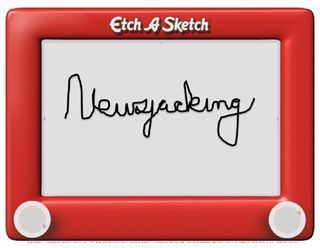 Here in the U.S., if you're plugged into real-time news, you can't avoid hearing about the Etch a Sketch brouhaha.
Here in the U.S., if you're plugged into real-time news, you can't avoid hearing about the Etch a Sketch brouhaha.
An aide to Republican candidate Mitt Romney said in an interview that the candidate could reset his campaign after he wins the primary battle "like an Etch a Sketch."
The reference to the classic toy which is familiar to so many played into the narrative that Romney changes positions frequently to appeal to whoever he is talking to at that moment. In many ways it was a perfect story and journalists ran with it resulting in thousands of stories mentioning the toy. (See below for a Google News image of the thousands of stories).
The Etch a Sketch is produced by Ohio Art, a family-run business. The toy has sold more than 100 million units worldwide since its introduction in 1960. I had one when I was a kid and played with it a lot.
When the newsjacking opportunity falls in your lap
Sometimes, the Newsjacking gods shine on you and present an opportunity that is so perfect that you can't help but jump in. So how to do it to the most effect?
So far, Ohio Arts has done an excellent job with media relations but has missed a huge opportunity to create original content.
Get in front of journalists
At least three Ohio Arts executives are doing media interviews. They are using humor, which gets some wonderful quotes into stories like this one which I love from a Wall Street Journal piece Ohio Art's Etch A Sketch Shakes Up Political Debate:
One thing the Etch A Sketch won't do is pick sides in the campaign, Martin Killgallon, the company's marketing director said. "We have a left knob and a right knob," he said, "so we neutrally speak to both parties."
Product placement
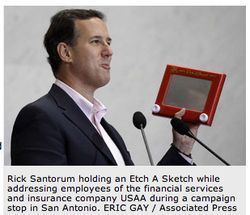 The company sent boxes of Etch A Sketches to the campaigns because candidates including Rick Santorum and Newt Gingrich have been holding up the toy, generating tons of images in the media.
The company sent boxes of Etch A Sketches to the campaigns because candidates including Rick Santorum and Newt Gingrich have been holding up the toy, generating tons of images in the media.
When yours is the product of the moment, particularly when it is such an awesome visual, you can generate ink just by having people hold it in front of cameras.
Missed content marketing opportunity
The only mistake the company is making is that they have not created any original content to take advantage of the sudden media interest.
There is no fun photo on the Ohio Art homepage, no press release in the media section, and nothing new on the company Ohio Art YouTube channel.
March 21, 2012
Real-time journalism means new opportunities for PR pros
Freek Janssen writing for Lewis PR in a blog post Why Real-Time Journalism Requires Newsjacking provides us with a terrific expansion on the ideas in my Newsjacking book.
Freek writes: "Reporters are constantly looking for context and insights for their stories – newsjacking allows PR to become a source, not just for the benefit of being quoted. This is profoundly changing the world of PR: we are there much more to help clients become sources than to just communicate news or a message – brands are increasingly using their own channels for that."
In his post, Freek shares a link to an excellent video from the UK's Guardian newspaper on how their journalists cover stories in real time. The video shows what goes down in newsrooms by imagining how reporters might cover the story of the three little pigs in print and online. It is definitely worth a watch.
Note: The video may open with an advertisement.
Direct link to Guardian open journalism: Three Little Pigs on YouTube.
Real-Time Public Relations
Today's real-time journalism means there is room for anybody to add their take to breaking news stories simply by blogging or tweeting or commenting.
But you've got to be quick. Review cycles usually mean failure.
For PR pros, this is not endless pitching on your timetable. It means turning the PR relationship around and providing information at the precise moment that journalists are looking.
March 19, 2012
Content Marketing Obama style with The Road We've Traveled
Late last week, Obama for America (President Obama's reelection operation) released a 17-minute film called The Road We've Traveled.
It's interesting timing for this content marketing effort because the Republican challengers for the nomination are locked into a protracted battle that is unlikely to be decided until this summer.
The film is worth a look because it is classic content marketing. It is an excellent example of using video to tell a story.
As regular readers of my blog may recall, I love looking at US presidential campaigns as case studies in marketing that can be applied by all sorts of organizations. This is not a political blog, nor am I supporting a particular candidate by highlighting what they are up to.
The Road We've Travelled is directed by Davis Guggenheim and narrated by Tom Hanks. It gives an inside look at some of the decisions President Obama made and featues interviews with President Bill Clinton, Vice President Joe Biden, Mayor Rahm Emanuel, Elizabeth Warren, David Axelrod, and others.
Direct link to The Road We've Traveled on YouTube and on the Obama for America site.
Using video to tell a story
No matter what sort of organization you're part of, a short film featuring interviews is a great form of content marketing. It works for companies, educational institutions, rock bands, nonprofits, individuals, and, well, any organization.
March 16, 2012
My keynote at the 2012 NAMM show now freely available
 I delivered a keynote presentation at The NAMM Show on January 20, 2012 in Anaheim, CA. The NAMM Show is one of the largest music product trade shows in the world, founded in 1901
I delivered a keynote presentation at The NAMM Show on January 20, 2012 in Anaheim, CA. The NAMM Show is one of the largest music product trade shows in the world, founded in 1901
My interactive presentation to 1,287 audience members (people were scanned as they entered so we know exactly how many were there) was titled Real-Time Marketing & PR and was based on my bestselling book of the same title. I show how to instantly engage your Market, connect with customers, and create products that grow your business now.
Direct link to the speech on Vimeo.
Here's the NAMM post about my speech.
It is an honor to be able to work such an awesome stage with such an enthusiastic audience! I appreciate the gift I am given every time I am asked to speak.
Make it free
Several things important things come to mind about this video: 1) I am releasing it freely on the Web and 2) NAMM is offering it freely on their site. So many speakers want to control their content and not allow people to see the video. "I'm a paid speaker," many speakers say. "Why should I give away my speech?"
Conference organizers are reluctant to give away content for fear that people won't buy a ticket for next year's event if they can count on the content being available.
Content drives action.
Get your valuable content out there where people will find it in search engines and will share it via their networks.




